A big bench press garners respect. As soon as someone finds out you lift weights, their first question is: “how much ya bench?”
The barbell bench press is the best way exercise to build a strong, powerful upper body. It’s a foundational compound movement–like doing squats for muscular quadriceps or deadlifts for strong glutes and hamstrings.
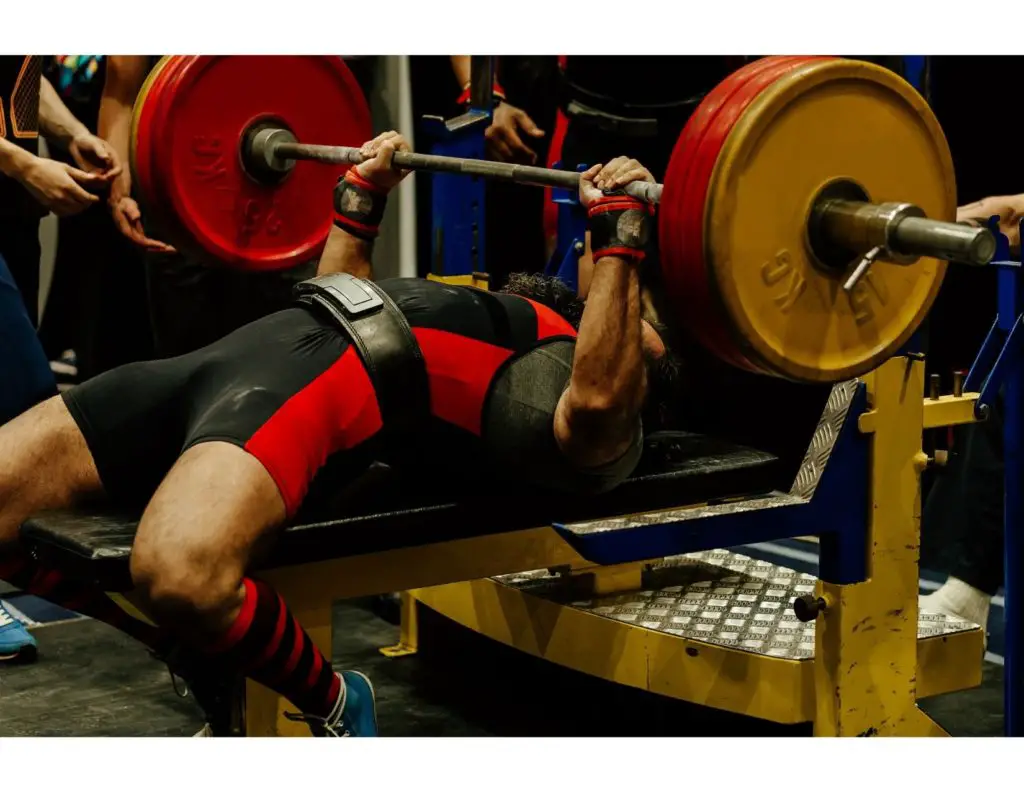
Unfortunately, the bench press is taxing on the shoulders, especially when it’s performed with poor technique. Shoulder injuries often obstruct the path to a big bench press.
I’ve been there too. Shoulder impingement kept me off the bench press for several months. The pain hampered my ability to overhead press and train my upper body. I recovered thanks to rest, NSAIDs and rotator cuff strength exercises. Since then, I’ve added 40 lbs to my bench press.
(At this point you’re probably wondering how much I bench. My current PR is 360lbs–with pause on the chest–at a bodyweight ~208lbs)
If you’re looking to bench press without shoulder pain and lift heavier weight, you’ve come to the right place.
Try these 10 tips to bench press without shoulder pain:
1) Heat Up
Especially in a cold gym, it’s a good idea to warm up before loading heavy weights onto your shoulder joints and rotator cuff muscles. Muscles and tendons function better when they’re warm. Getting warm is the first thing you should do before you start lifting.
There are many ways to warm up–just do something to get your body warm and blood pumping. Ride the stationary bike, use the rowing machine, knock out a round of pushups, do jumping jacks, hammer out a few burpees, or hit the heavy bag.
For tight, sore muscles, a massage gun is your best friend. It relieves muscle soreness without reducing your strength (1), like static stretching does. Nothing warms up stiff pec muscles before a bench press session like a massage gun.

There are many percussion therapy tools you can use. Here are 3 great options:
Theragun PRO
This is a top-of-the-line massage gun. It comes with 6 different attachments and a rotating arm for easy ergonomics. It feels amazing on sore, tight muscles. Plus, it’s a quiet model with preloaded routines.
It’s easy on the body, less so on the wallet. Check the price here.
Hypervolt Plus
I use the Hypervolt in the PT clinic. My patients love it. It has 3 speeds and 5 attachments. The battery last up to 3 hours between charges.
At half the price of the Theragun Pro, it’s a sturdy, high-value option. See it on Amazon here.
Renpho Massage Gun
This one is a budget-friendly option for giving your muscles some TLC. Plus, it’s rated 4.5 on Amazon (over 37,000 reviews) and comes with 5 attachments.
2) Start at the Bar
I don’t mean you should down a few brews before your bench press session. (Nice try!)
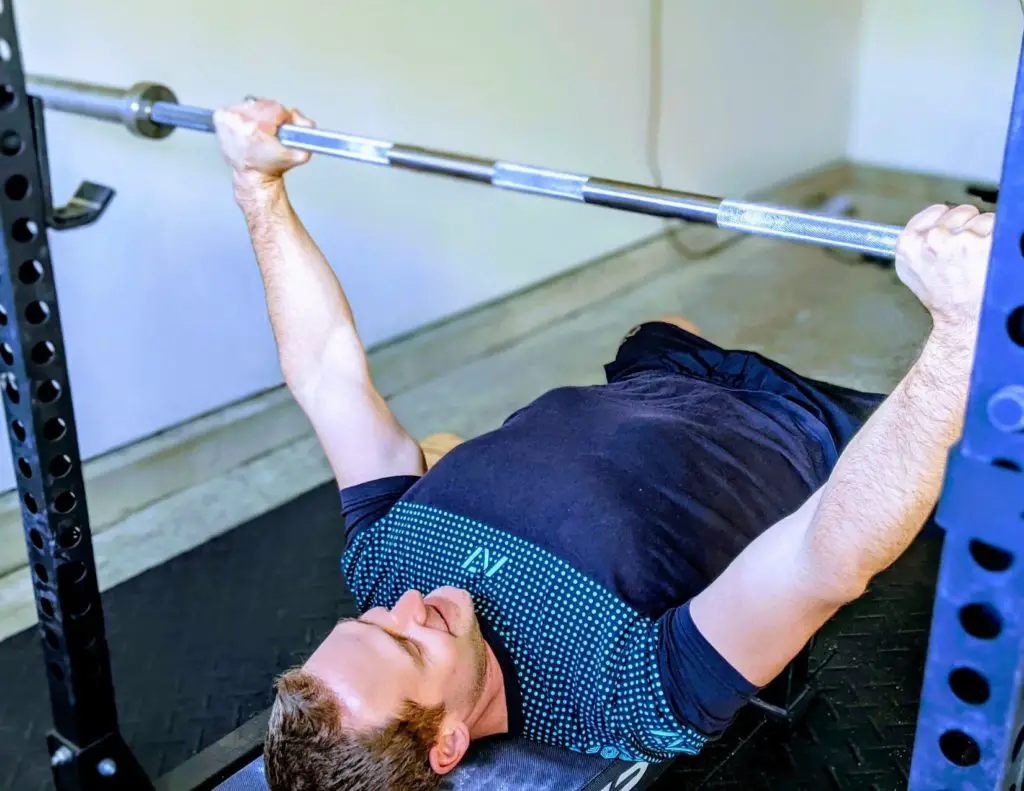
I mean that bench pressing the barbell 10-20 times is the best way to start your workouts. Elite powerlifters who bench >450 lbs warm up with just the bar, so it’s not too light or too basic for you. Starting with too much weight is a common mistake.
I start my bench press workouts with the bar, and slowly add weight (in 40-50 lb increments) to get my body acclimated to heavier and heavier weight. Here’s how I do it (repetitions x weight):
10xbar
8×95
6×135
4×185
3×225
2×275
1×305
Then, I perform a heavy single (typically 310-350 lbs) before doing lighter weight at higher repetitions (for example, 4 sets of 8 reps at 235 lbs).
Prepare your body for bench press. Warm up properly and gradually add weight to the bar. Your shoulders will thank you.
3) Retract Your Shoulder Blades
The bench press looks simple: lay on your back, bring the weight down to the chest, then push it back up. But lifting with proper form is more nuanced.
Poor shoulder blade position increases stress on the shoulder joints. To position your shoulder blades properly for bench press, squeeze them down and back.
This motion is called “scapular retraction.” Try it out!

Some coaches use the “knife in the back” cue. A bit morbid, but effective. Another helpful cue is “squeeze a pencil between your shoulder blades.”
Maintain this position as you bench press. Retracting the shoulder blades elevates the chest, shortens the range of motion for the lift, and keeps the shoulders in a safer, more efficient position.
4) Arch Your Back
Along with retracting your shoulder blades, arching your back is another easy way to reduce shoulder pain and lift more weight.
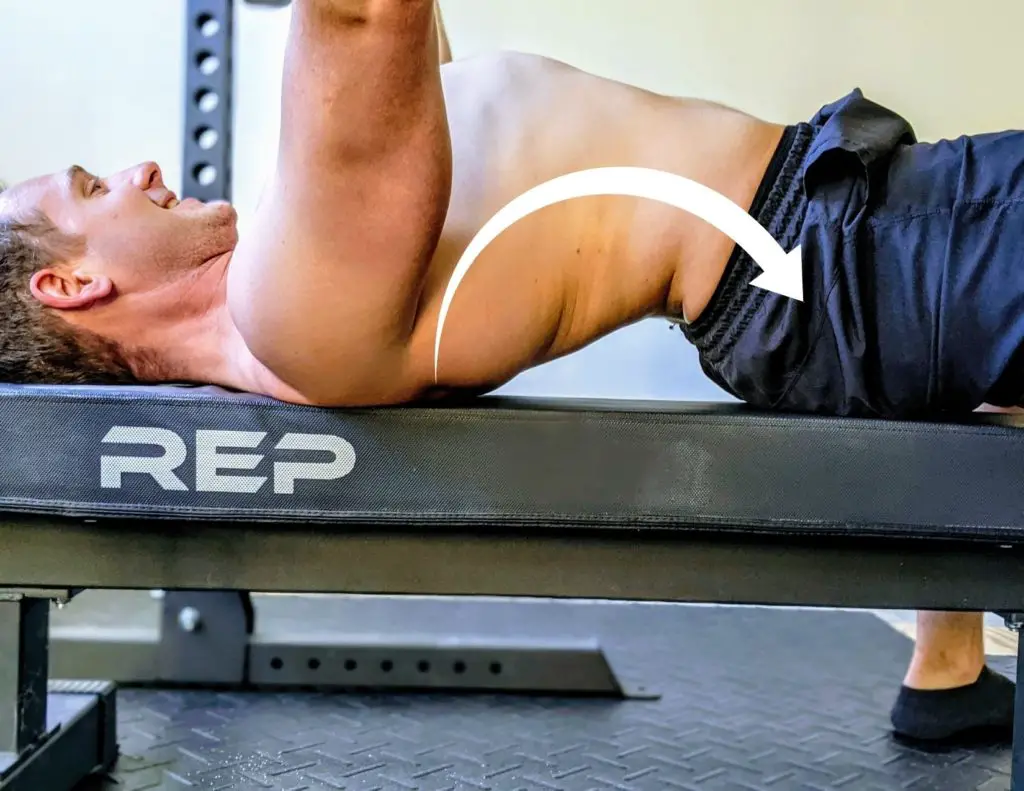
It’s a trick of the trade many powerlifters use to lift incredible amounts of weight.
An arched back turns a flat bench press into a slight decline press. Many lifters are stronger from this position anyway.
An arched back makes the lift easier by shortening the range of motion. Most important, it’s easier on the shoulders.
5) Get a Grip
To keep this tight, strong position with the shoulder blades retracted and the back arched, friction is your friend. Your upper back needs a good grip on the bench.
Some benches are as slippery as a wet bar of soap. So a perfect, tight starting position can disintegrate after one or two repetitions.
There are several strategies to make your upper back stick to the bench press.
Chalk
It’s cheap and effective. But beware, many gyms frown upon chalk use, especially if you make a mess. Please use responsibly–so it’s not banned for the rest of us!
If your gym allows chalk (or you’re sneaky enough to avoid detection), use chalk on the bench and on your upper back where it contacts the bench during your lift. Your shoulder blades will stay retracted and your shoulders will thank you.
Snag some lifting chalk here.
Resistance Bands
Alternatively, stretch one or two resistance bands lengthwise down the bench. Resistance bands provide unbelievable grip between the bench and your upper back.
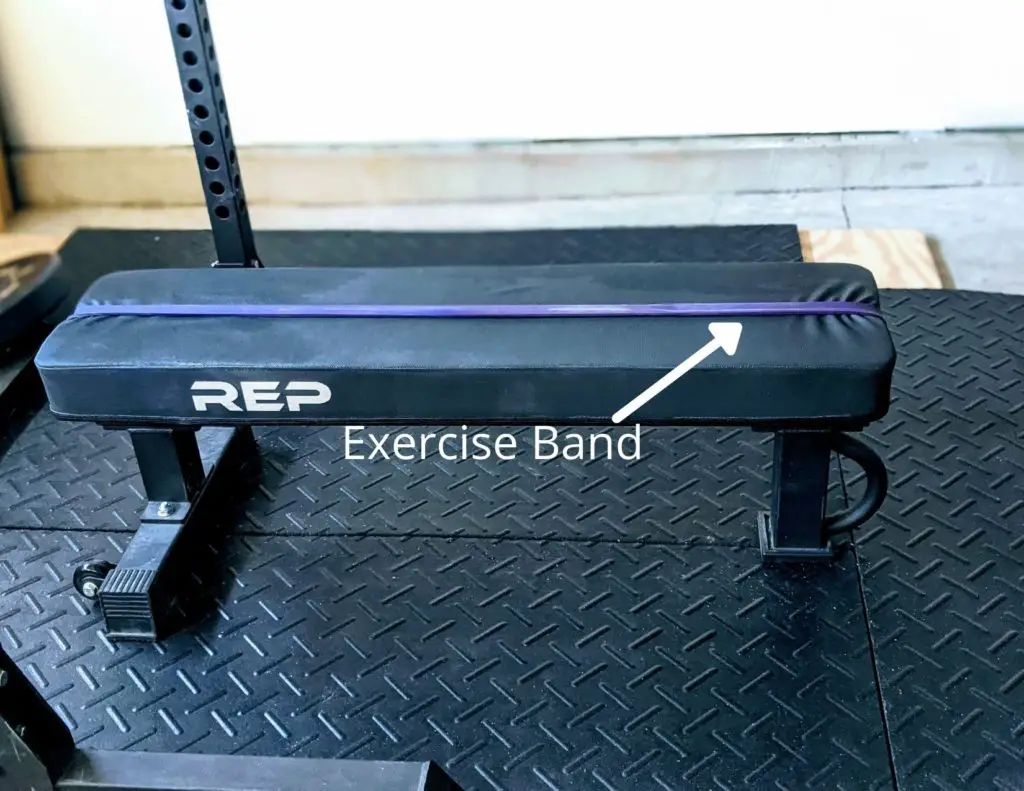
It’s a cleaner option than chalk. Plus, you’ll get fewer dirty looks from the gym staff. Use a thick resistance band on the bench for maximum grippage.
A7 Shirt
Finally, you can buy specialized shirts with built-in grip on the upper back. I own 5 of these shirts from A7. They provide excellent grip on the bench press to glue your shoulder blades to the bench.
They’re great for barbell squats, too. The shirt’s rubberized grip keeps the bar from rolling around the upper back, even with heavy squats.
6) Strengthen Your Rotator Cuff
Rotator cuff exercises helped me beat shoulder impingement and resume bench press training after shoulder pain forced me to take several months off.
I’m especially fond of strengthening the shoulder muscles that perform external rotation. The external rotators, also known as the posterior rotator cuff, are an essential group of muscles for overhead athletes (2).
They are weaker than the internal rotators, yet essential for shoulder stability in overhead positions. Athletes like baseball players, tennis players, and volleyball players wisely focus on strengthening the external rotators.
Check out this article for simple exercises to strengthen the rotator cuff:
8 Infraspinatus Exercises to Build a Strong Rotator Cuff
7) Release Your Pecs
The pectoralis (chest) muscles and anterior deltoids (front of the shoulder) work hard during the bench press. When these muscles are overworked, they develop tight spots called trigger points. Tight pecs and delts cause shoulder pain for many lifters.
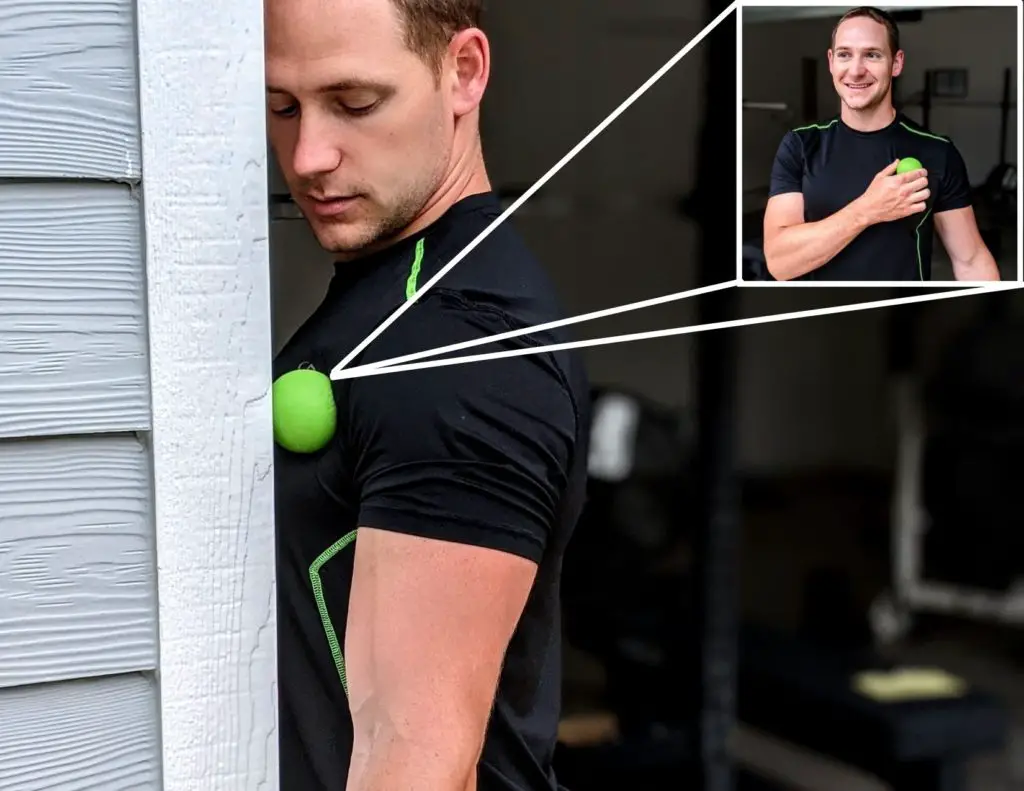
Use a massage gun, grab a tennis ball, or use a lacrosse ball to smash those trigger points and relieve pain.
8) Know Your Levers
A wider grip on the bench press works the pec muscles harder. A narrow grip trains the triceps and anterior deltoids.
An ultra narrow grip places excessive stress on the glenohumeral joint (shoulder joint) because it requires the shoulder to extend a lot. Shoulder extension occurs when the upper arm moves towards the ground, past the torso.
This translates to more work for the deltoids and triceps during the lift. Even worse, it limits the amount of weight a lifter can bench press.
It’s important to understand how your grip width affects different muscle groups during the bench press. That way, if one muscle group is sore or injured, you can modify your training appropriately.
9) Grip Wider (or Narrower)
Depending on your problem area, adjusting your grip width may ease or erase shoulder pain.
Most people bench press with a grip that’s too narrow.
A shoulder width grip isn’t wide enough for 90% of lifters. My grip width (shown below) is well outside shoulder width, but still too narrow for my liking.
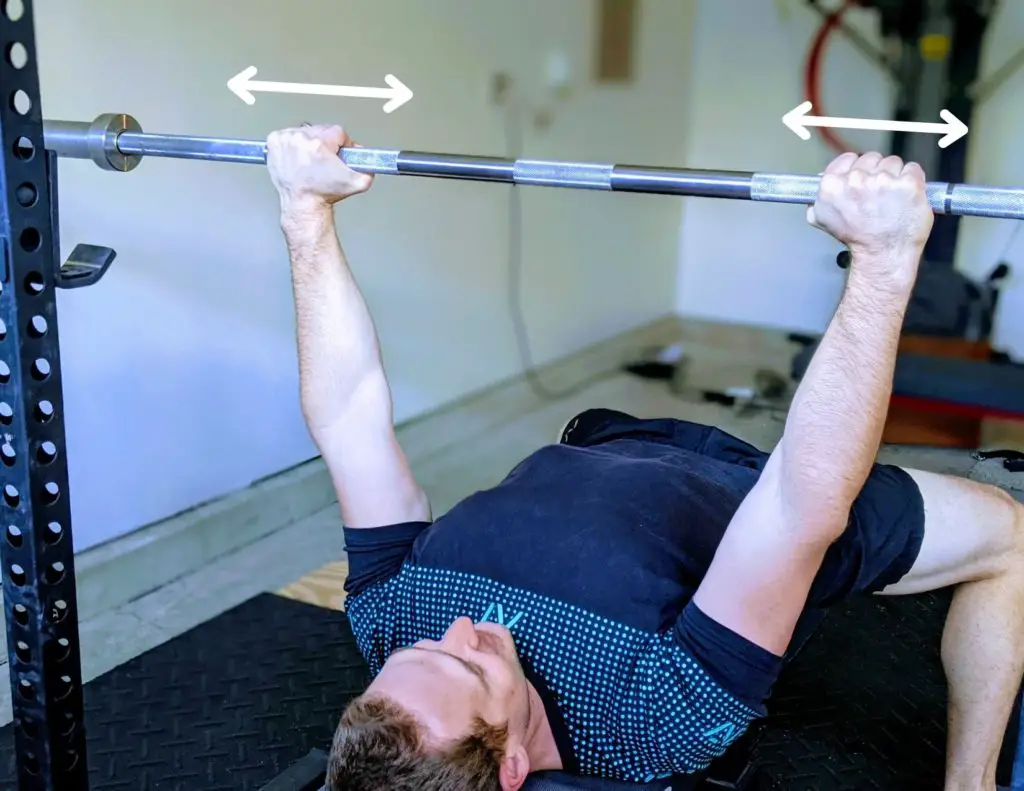
Here’s a good rule of thumb: Look for vertical forearms when the bar is on the chest (seen from behind the lifter). Find this grip width, then narrow or widen your grip based on what feels strong and comfortable.
I have long arms and strong pecs, so I lift a wide grip, with my index fingers on the rings. Shorter, stouter lifters (or lifters with stronger triceps) can press more weight with a narrow grip.
10) Build Slowly
Everyone wants a bigger bench press. If it were easy, everybody would push 300 or 400 lbs on a light day.
But it’s not.
Boosting your bench press numbers takes time, dedication, and discipline. Going for a PR every session is a recipe for shoulder injury and stalled progress.
Instead, opt for lighter weight. Follow a well-written training program. Put in the work on the mediocre and average days, and push harder on the days you’re feeling strong.
Smart training and consistent progress is the only route to hitting big bench press numbers. There are no shortcuts.
Bonus Tip: Work with a Physical Therapist
PTs are movement experts. Working with a physical therapist is your best option to overcome a chronic shoulder problem or severe pain.
Some skilled personal trainers do a great job teaching the bench press. But physical therapists have much more rigorous training in anatomy, biomechanics and pain science. Physios are pain management pros.
Your best bet is to find a physical therapist who specializes in Sports or Orthopedics. Find a specialized PT near you with this search tool: APTA Specialist Directory
Readers: Have you dealt with shoulder pain on the bench press? Share your experience in the comments.
For more fitness insights you won’t find anywhere else, join the free, fast-growing Facts & Physio Newsletter. Plus, get The Recovery Checklist when you sign up.

